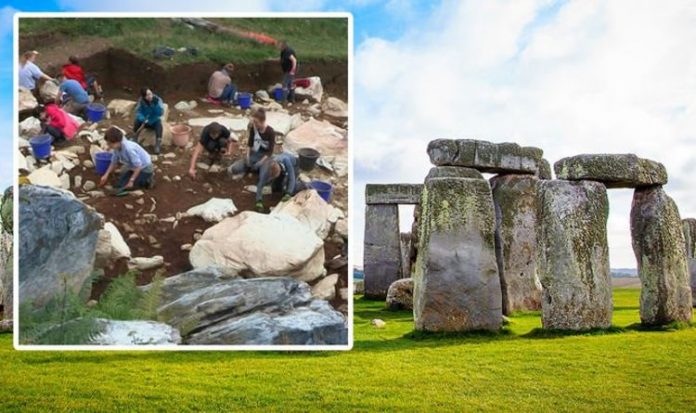Experts put forward a new theory on the ancient monument during BBC Two’s ‘Stonehenge: The Lost Circle Revealed’ documentary last night. They now believe a dismantled stone circle in west Wales is likely to have been used as the original building blocks for the site that stands today in Salisbury, Wiltshire. Excavations and analysis of the site at Waun Mawn, in the Preseli Hills, dated the stone circle to around 3400BC, making it the oldest found in Britain.
The ‘Stone of Stonehenge’ investigation was led by Professor Mike Parker Pearson of University College London and his team found several of the monoliths are of the same rock type and one of the bluestones at Stonehenge matches a hole left in Wales.
But the catalyst for the new theory is almost as incredible as the discovery itself.
Speaking during the documentary, Professor Alice Roberts said: “Archaeologists unearthed the puzzle, sparked by the charred remains of a Neolithic snack.
“At the Craig Rhos-y-felin quarry, the team excavated hazelnut shells from around a Stone Age fire pit.
“More than 5,000 years ago, somebody was sitting just around here eating some hazelnuts for their lunch, just as I am – throwing the shelves into the fire.
“It’s an astonishing detail of Neolithic life and I love these beautiful moments frozen in time.”
However, the discovery fuelled more than just an intriguing story.
Prof Roberts added: “These hazelnuts introduced such a twist to the story.
“The charred hazelnut shells were gathered up and radiocarbon dated, and the results caused a stir.
READ MORE: Stonehenge discovery ‘like nothing seen before’ fueled new theory for ancient site
“They had been burned around 3300BC, suggesting the bluestones had been quarried almost four centuries before Stonehenge was constructed.”
At the time of the filming, Prof Parker Pearson remarked: “I think there was another place, maybe close by that these were initially destined for.”
And it would appear his prediction came true.
Experts now theorise that the stones used for Stonehenge were transported by the Neolithic civilisation to become Britain’s first “monument to unification” in 3000BC.
Radiocarbon dating previously suggested the structure was “second hand” and its smaller bluestones stood for four centuries in another location after being quarried in South Wales.
Prof Parker Pearson believes it is possible that people moving eastward and bringing their cultural “crown jewels” with them from ancestral homelands in Wales is a likely theory.
DONT MISS
End of the world: How archaeologist discovered ‘real Maayan doomsday’ [VIDEO]
Mayan DISCOVERY: How find in ancient city ‘reveals creation story’ [CLAIM]
Egypt: How ‘greatest archaeological find of all time’ stunned expert [REVEALED]
It was already known that the smaller bluestones that were first used to build Stonehenge were transported from 150 miles away in modern-day Pembrokeshire.
But Waun Mawn is now being tipped as the original monument because it lies next to quarries where Stonehenge’s smaller bluestones originate, its perimeter ditch has the same diameter and is also aligned with the midsummer solstice sunrise.
Archaeologists believe this could explain why the bluestones used at Stonehenge were brought from so far away, while most circles are usually constructed within a short distance of their quarries.
With only a few of the Stonehenge stones directly linked to Waun Mawn, the archaeologist believes monoliths from other stone circles could have been taken from Wales to form part of the new monument.
Prof Parker Pearson said: “With an estimated 80 bluestones put up on Salisbury Plain at Stonehenge and nearby Bluestonehenge, my guess is that Waun Mawn was not the only stone circle that contributed to Stonehenge.
“Maybe there are more in Preseli waiting to be found. Who knows? Someone will be lucky enough to find them.”
You can watch ‘Stonehenge: The Lost Circle Revealed’ on BBC iPlayer now.







